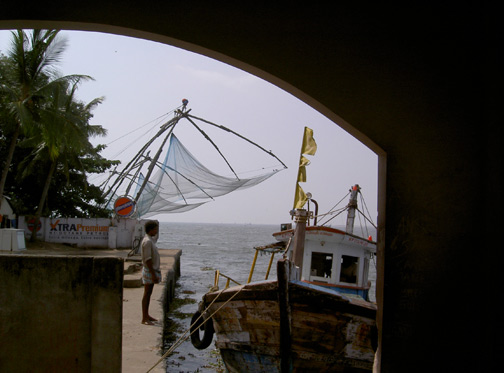
Pam and I arrived in the city of Kochi, Kerala on Monday. On some maps the city is called Cochin, but I’ll bet this piece of turf and important harbor has had many, many names. The picture shows a modern man in his western style shirt and lungi. A lungi is like a sarong, it is a single sheet of fabric wrapped tight at the waist and folded to hold his manly parts from banging around too hard. Do you remember my picture about the underwear billboard in Delhi which used a marketing slogan of “hands free comfort,” and my response was something like, “it must be a cultural thing that will explain itself later.” Well, I think the lungi is the answer. It is very common to see men on the sidewalk partially unwrap their lungi and rewrap for tightness. If you wear briefs instead, you have “hands free comfort.” If I ever get a lesson which shows me the inner sanctum of a lungi, I’ll let you know.
Chinese fleets brought spices and trade goods to Kerala from points further east. These same fleets traded further west to the coast of Africa. If you believe the author of the recent book titled “1421. The Year the Chinese Discovered America” then the Ming Dynasty fleets went way beyond Africa. Read it, it’s a good book and startlingly believable written by a former navigator from the British Navy, who applies modern navigational principles to maps found in historical archives. He makes a few big leaps in his conclusions, but still well done.
The picture shows Chinese nets originally introduced from China by traders. These nets are lowered for many hours into the changing tide flow at the harbor channel and raised later with mucho fish. The picture also shows a fishing boat which resembles our lobster boats, which need petrol supplied by this harbor side station. Kochi is still a very, very busy port. Huge merchant ships are leaving and entering this historic harbor continually.


